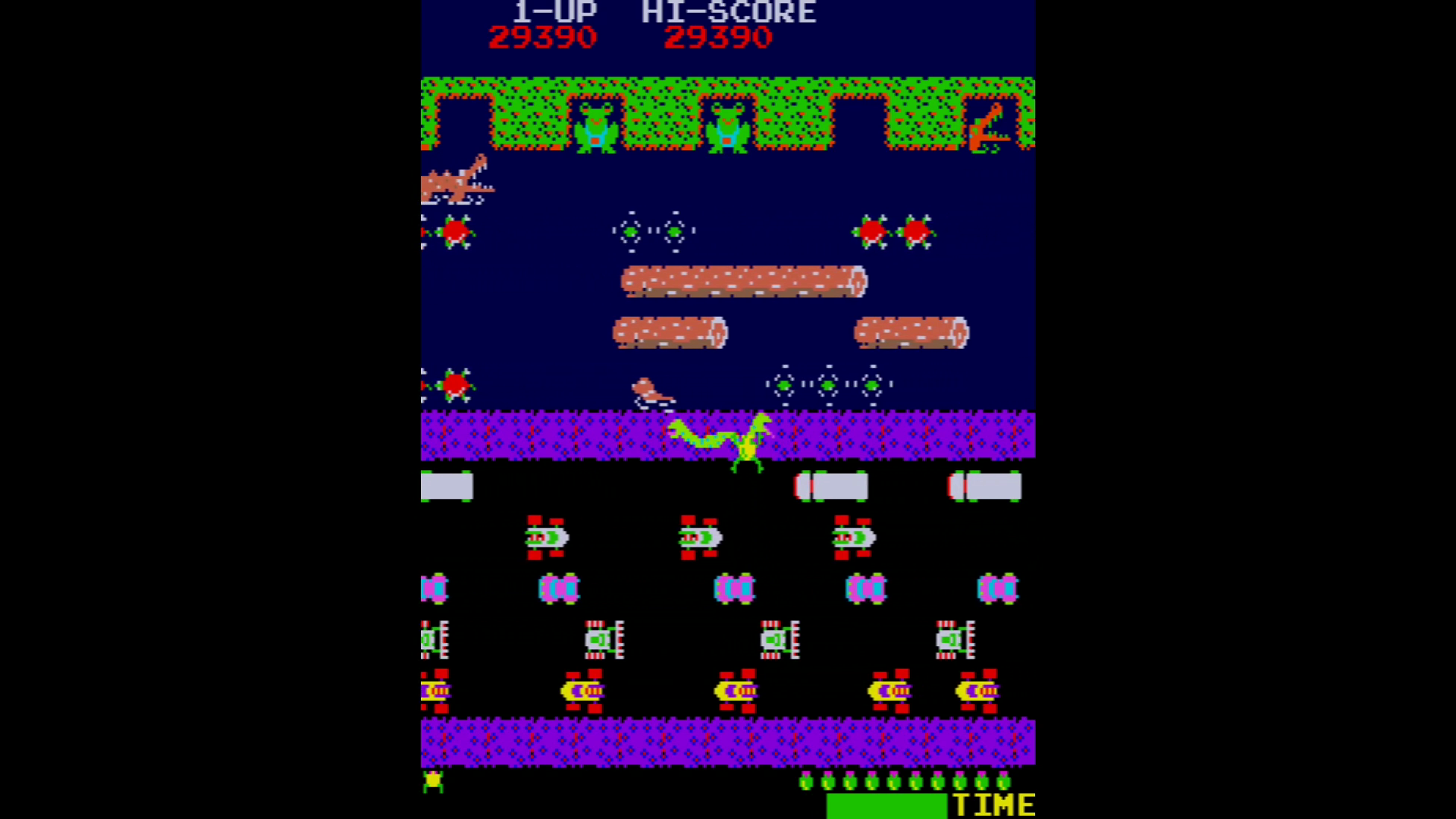Frogger is such an iconic arcade game. It is a cute arcade game that everyone enjoys to this day.
Let’s talk about Frogger and the story of how it got released to arcades in the 80s because it almost didn’t happen.
Frogger Gameplay
You control a frog that has to cross roads and rivers while avoiding obstacles to reach your home on the other end of the screen.
There are an infinite amount of levels. After level 10 you will see the same patterns of obstacles and enemies repeat every 5 levels. So level 10 will have the same exact pattern as level 15. Also the same layout as level 20 and so on.
Frogger Enemies and Obstacles
Frogger has cars and trucks, turtles and floating logs to hop on, alligators (not crocodiles), otters, and snakes.

Frogger – The Arcade Game’s History
Frogger was developed by Konami. Konami is known for plenty of iconic video game series (Contra, Castlevania, Metal Gear, and much more) still around and kicking today.
But before all that, Konami got their start by developing arcade cabinet games in the late 70s.
A couple of those first arcade games were Space King and Space King 2.
These arcade games were almost exact clones of the already popular Space Invaders game. Konami had made quite a few arcade cabinets clones of other games that were already released.
In 1981, Konami made Frogger. It would be one of the most memorable and influential arcade games ever made. It’s up there with Pac-Man, which both seemed to have an arcade cabinet at every skating rink and pizzeria in the 90s.
Frogger has been a big part of pop culture. Seinfeld even had an entire Frogger-themed episode where George Costanza had to move a Frogger cabinet across the street to save his high score he got as a kid.
Konami developed Frogger, yet Sega (Sonic the Hedgehog fame) published the game.
The Frogger Story with Sega – Frogger Almost Didn’t Exist
Sega almost didn’t release Frogger. It has a crazy history that can be read in the book by Ken Horowitz called The Sega Arcade Revolution. Which is an awesome book and you should give it a read if you are interested in arcades or just video game history in general.

Sega was worried about Frogger’s earning potential. They were worried because they already released a frog-related arcade game, called Frogs, just 3 years earlier, in 1978, which was a massive flop.
And Sega also did not think the basic gameplay and cute presentation would persuade the male-dominated gamers of the day to spend their quarters on it in the arcade.
The only reason Sega released Frogger was because of a market researcher at Sega named, Elizabeth Falconer. She convinced her bosses that Frogger deserved a chance.
Elizabeth met with executives from Paramount, which was a company owned by the same company that owned Sega, to present her pitch for Frogger. She gave out booklets that showed Frogger’s simple gameplay and sales potential. An executive at this meeting threw the booklet at Elizabeth and said…
“Frogger has already been rejected because it was a women and kids game.”
She replied that those executives were also the ones who turned down Pac-Man. This reply got the room’s attention.
Elizabeth requested a test to see how potential arcade players will react. The room of big wigs gave in to her request and told the group from Sega to “let her have her (g-dang) kids game”.
So they agreed to a playtest of a Frogger prototype. But even though her bosses relented to her request, they stacked the cards against Elizabeth and her “kids” Frogger game.
The bar they chose to test Frogger was in a bar called “Spanky’s Saloon”. They thought this would ruin the playtest because the audience in this bar was mostly men.
Of course we all know how it ended. Frogger did exceptionally well at Spanky’s even though they thought men would not like it and Sega released Frogger to the public in 1981.
Frogger was such a simple, yet fun game, that had no age or gender barrier. Anyone one could pick it up and enjoy their time hopping across roads and rivers.
Where Can You Play Frogger?
Parker Brothers eventually got the license for Frogger from Sega and made many ports.
Frogger was ported to many home systems, including Timex Sinclair, Apple II, IBM PC, Commodore 64, Atari 2600, Intellivision, ColecoVision, Atari 5200, VIC-20, Atari8-bit family, and the TI-99/4A (yes, that’s the Texas Instruments company that later made calculators).
Frogger was Parker Brothers’ most successful first year product.
Hasbro Interactive received the rights to Frogger and remade the game in 3D on Windows and PS1.
To be confusing, Hasbro Interactive also released the original Frogger arcade game to the Game Boy, Sega Genesis, and the SNES. They released it a year later than the 3D remake but with almost the exact same cover art.

This also gave way to more ports of the original arcade game to the Xbox 360 arcade and as a mobile game.
You can also play the Arcade Archives version of the arcade Frogger game on Nintendo Switch and PS4. Frogger can pretty much be played on anything at this point.
Frogger’s Legacy
Watch the video below of the recap of this post. It will give more details and insights into Frogger’s history.
Frogger, the “women and kids” game that was almost not released, has been an important part of our culture. We can play Frogger today thanks in part to the persistent Elizabeth Falconer and, of course, the dirty bar where it all began, Spanky’s Saloon.
Further reading on classic arcade games: The Simpsons and X-Men arcade games.